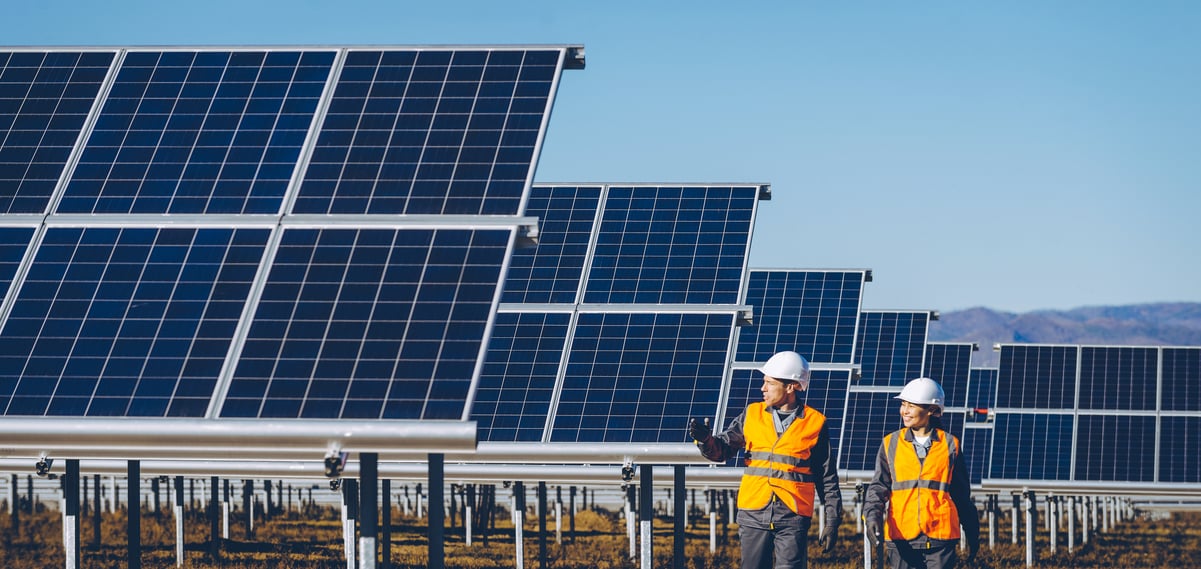For some, personal investments in renewable energy are nothing new. Whether driving a hybrid vehicle or installing solar panels on the roof or using wind-generated electricity from the local utility, millions of people around the globe now rely on green energy sources to help with their various power needs on a daily basis.
If they're looking to benefit from the growing adoption of nonconventional power sources, investors may want exposure to renewable energy stocks. While there are plenty of choices, First Solar (FSLR +1.05%), Ormat Technologies (ORA +0.94%), and TPI Composites (TPIC +20.91%) currently represent compelling opportunities.

Image source: Getty Images.
Let the sunshine in
Naysayers may contend that the solar industry is slowing down, but recent research suggests otherwise. A report from Wood Mackenzie and the Solar Energy Industries Association indicates that the future for solar power in the utility-scale market remains bright, with the pipeline of projects now at a record level.
That presents a significant opportunity for First Solar, a manufacturer of thin-film solar modules that are ideally suited for the utility-scale market. And with the recent start of operations at its second factory in the U.S., First Solar proclaims itself the largest photovoltaic module manufacturer in the Western Hemisphere.
During its recent third-quarter earnings report, it revised 2019 guidance upward. Whereas management had previously forecast operating income of $290 million to $340 million, it now expects $320 million to $370 million -- a noteworthy increase over the $40.1 million and $177.9 million that it reported in 2018 and 2017, respectively. And in light of the company's success in growing its pipeline, the future beyond 2019 also seems auspicious, substantiating the claim that the solar industry is continuing to grow.
Through the first nine months of 2019, for example, First Solar has booked orders totaling 5.4 gigawatts GW), an increase over the 5.2 GW it booked during the same period in 2018. Moreover, the company states that it has 8.1 GW of mid-to-late stage opportunities in the pipeline, representing growth over the 7.9 GW which it had at this point in 2018.
Water, water everywhere
For those uninspired by the power of the sun, perhaps power generated with the help of water will charge them up. Proclaiming itself as the "world's only vertically integrated geothermal company," Ormat Technologies owns and operates a portfolio of assets representing 917 megawatts (MW) of power. And management seems confident that the company's portfolio will soon pass the 1 GW threshold, revealing in an investor presentation this past summer that the company expects to add 125 MW to 135 MW of power from organic growth by the end of 2021. More than the company's geothermal solutions, though, I find management's interest in expanding into the energy storage market especially exciting, for a recent report from Wood Mackenzie Power and Renewables "projects that energy storage deployments will grow 13-fold over the next six years." Providing various services pertaining to energy storage, Ormat Technologies offers battery storage as a service, engineering and integration of energy storage facilities, and the operation of assets.
In terms of the company's financials, over the past five years, management has proved to be adept at growing both the top and bottom lines. From 2014 to 2018, for example, Ormat has grown revenue and EBITDA at compound annual growth rates of 7.5% and 7.9%, respectively. Turning from the income statement to the balance sheet, savvy investors may question the company's financial health as companies that operate large assets such as Ormat does can find themselves burdened with heavy debt. With a net-debt-to-EBITDA ratio under 3, however, there appear to be no red flags here.
The answer is blowin' in the wind
According to a recent report from the International Energy Agency, wind power is poised for significant growth. The report finds that "global offshore wind capacity may increase 15-fold and attract around $1 trillion of cumulative investment by 2040." Take into account the growing number of onshore wind projects, and it's clear that TPI Composites, a manufacturer of composite wind turbine blades, presents an intriguing opportunity -- especially since the company estimates that its customers currently represent 99% of the U.S. onshore wind market and 55% of the global onshore market.

Image source: Getty Images.
Since the company inks long-term supply agreements, management contends that there's insight into its future revenue. In a recent investor presentation, for example, management noted that based on current agreements, TPI Composites has up to $6.2 billion in potential revenue through 2023. Should the company succeed in booking this amount in sales over the next five years, it will represent 71% growth over the more than $3.6 billion in revenue that the company reported from 2014 through 2018. Management, moreover, expects this top-line growth will lead to increases on the bottom of the income statement. On the company's Q2 2019 conference call, CEO Steven C. Lockard stated that the company "remain[s] in position for profitable growth, significant free cash flow, and compelling return on invested capital as the industry matures."
The renewable energy rundown
Forward-looking investors who are eager to invest in green energy businesses may find the choices overwhelming, but First Solar, Ormat Technologies, and TPI Composites are three compelling options that can provide good footholds.
With a history stretching back 20 years, First Solar has proved itself to be a stalwart name in the solar industry, and it seems as if there are plenty of bright days ahead. Investors who find themselves more motivated to act based on the growth trajectory of the wind industry, however, will find that TPI Composites and its extensive reach through the industry may put the wind in their sails. Meanwhile, Ormat Technologies, with its focus on expanding into the energy storage market, represents another intriguing possibility.








